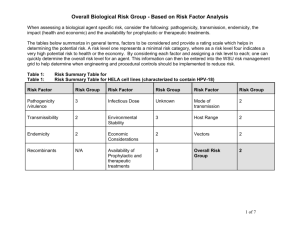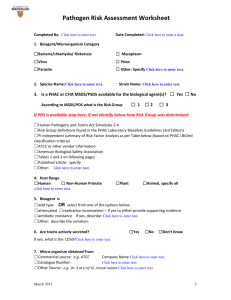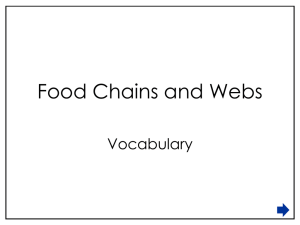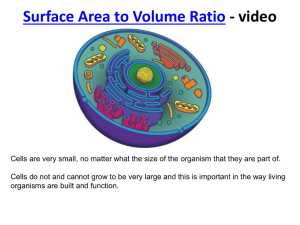HEK 293 Cell Line RG Risk Assessment
advertisement
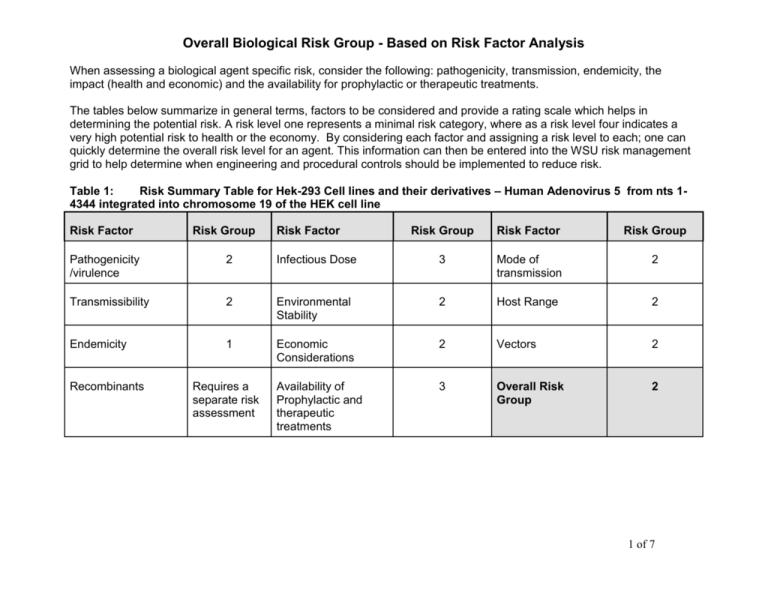
Overall Biological Risk Group - Based on Risk Factor Analysis When assessing a biological agent specific risk, consider the following: pathogenicity, transmission, endemicity, the impact (health and economic) and the availability for prophylactic or therapeutic treatments. The tables below summarize in general terms, factors to be considered and provide a rating scale which helps in determining the potential risk. A risk level one represents a minimal risk category, where as a risk level four indicates a very high potential risk to health or the economy. By considering each factor and assigning a risk level to each; one can quickly determine the overall risk level for an agent. This information can then be entered into the WSU risk management grid to help determine when engineering and procedural controls should be implemented to reduce risk. Table 1: Risk Summary Table for Hek-293 Cell lines and their derivatives – Human Adenovirus 5 from nts 14344 integrated into chromosome 19 of the HEK cell line Risk Factor Risk Group Risk Factor Risk Group Risk Factor Risk Group Pathogenicity /virulence 2 Infectious Dose 3 Mode of transmission 2 Transmissibility 2 Environmental Stability 2 Host Range 2 Endemicity 1 Economic Considerations 2 Vectors 2 Availability of Prophylactic and therapeutic treatments 3 Overall Risk Group 2 Recombinants Requires a separate risk assessment 1 of 7 Table 2: Risk Factor Assessment Table Risk Factor Risk Level 1 Pathogenicity / Unlikely to cause Virulence disease, low individual and community risk Infectious Dose Mode of Transmission / Route of Infection Risk Factor Ability to Spread / Transmission / Communicability Risk Level 2 Mild or moderate disease, moderate individual risk, low community risk, any pathogen that can cause disease but under normal circumstances, is unlikely to be a serious hazard to a healthy laboratory worker, the community, livestock or the environment Risk Level 3 Serious livestock, poultry or wildlife disease; high individual risk, low community risk: any pathogen that usually causes serious disease or can result in serious economic consequences or does not ordinarily spread by causal contact form one individual to another Risk Level 4 Severe livestock, poultry or wildlife disease / high individual risk, high community risk, also causes human disease, any pathogen that usually produces very serious and often fatal disease, often untreatable and may be readily transmitted form one individual to another, or from animal to human or vice-versa, directly or indirectly, or by casual contact. High (1-10 organisms) Not applicable (not known to cause disease in healthy adults) Not applicable (not known to cause disease in normal healthy adult plants or animals) Variable or high (1,0005,000 organisms or greater) Medium (10 –1,000 organisms) Primary exposure hazards are through ingestion, inoculation and mucous membrane route (not generally through the airborne route) May be transmitted Readily transmitted, through airborne potential for aerosol route; direct contact; transmission vectors Risk Level 1 Not applicable (not known to cause disease in normal healthy adult plants Risk Level 2 Geographical risk of spread if released form the laboratory is limited, very limited or no Risk Level 3 Geographical risk of spread if released from the laboratory is moderate, direct Risk Level 4 Geographical risk of spread if released from the laboratory is widespread 2 of 7 or animals) transmission is relatively limited Environmental Stability Not applicable Host Range Not applicable (not known to cause disease) Short term survival (days); can survive under ideal conditions Infects a limited number of species Endemicity Enzootic Economic aspects of introduction and/or release into the environment of the public No economic and /or clinical significance Risk Factor Availability of prophylactic and therapeutic treatments Risk Level 1 Not applicable (not known to cause disease) animal to animal or human to human transmission occurs relatively easily – transmission between different animal species may readily occur Resistant (days to months) Infects multiple species Highly resistant (months to years) e.g. spores Infects many species of animals/plants Generally enzootic (some low-risk exotics,zoonotics or reportable diseases) Limited economic and/or clinical significance Exotic, zoonotic or enzootic but subject to official control Severe economic and/or clinical significance Exotic Risk Level 2 Effective treatment and preventive measures are available Risk Level 3 Prophylactic and /or treatments may or may not be readily available (or of limited benefit) Risk Level 4 Prophylactic and/or treatments are not usually available Extremely severe economic and/or clinical significance 3 of 7 Disease Transmission Vectors Risk Factor Not applicable (not known to cause disease) Risk Level 1 Do not depend on vectors or intermediate hosts for transmission May depend on vectors or intermediate host for transmission Risk Level 2 May depend on May depend on vectors vectors or or intermediate host for intermediate host for transmission transmission Risk Level 3 Risk Level 4 4 of 7 Recombinants The recombinant is a risk group 1 organism; modifications have not changed the risk The recombinant is a risk group 2 organism; modifications have not changed the risk - DNA from risk group 2 or 3 organism is transferred into risk group 1 organism: but not the whole genome. - DNA from risk group 4 organism is transferred into risk group 1 organism (only after demonstration of a totally and irreversible defective fraction of the organism genome is present in the recombinant. - The recombinant is a risk group 3 or 4 organism; however, the modification has resulted in proven attenuation. The recombinant is a risk group 3 organism and modifications have not changed the risk - The recombinant is based on a risk group 2 organism, however, the modifications have increased the risk group to a 3. The recombinant is a risk group 4 organism; modifications have not changed the risk - DNA from risk group 4 organisms is transferred into a risk group 1 organism in the without being able to demonstrate a lack of virulence or pathogenicity. 5 of 7 Recombinants Continued: Consider the effect of the modification on all previous 10 risk factors; plus the NIH Guidelines provide standard risk group assessment based on the modifications. A comprehensive look at the effect of the modification is required. Consideration to be made include: Does the inserted material increase virulence or decrease the effectiveness of any anti-infective agents? Does the inserted gene encode a known toxin or a relatively uncharacterized toxin? Does the modification have the potential to alter the host range or cell tropism of the virus? Does the modification have the potential to increase the replication capacity of the virus? Does the inserted gene encode a known oncogene? Does the inserted gene have the potential for altering the cell cycle? Does the viral DNA integrate into the host genome? What is the probability of generating replication –competent viruses? If the modification has resulted in a form of attenuation, how extensively has this strain been utilized without incident and/or has the attenuation been proven in animal models? Does the modification have an effect of increasing or decreasing the efficacy of available treatment or prophylaxis? 6 of 7 7 of 7
